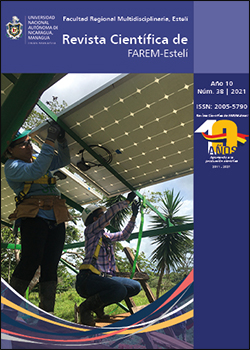Evolution of temperature and precipitation in four meteorological stations, located in the north-central region of Nicaragua, Central America
DOI:
https://doi.org/10.5377/farem.v0i38.11952Keywords:
Dry corridor, water deficit, evapotranspiration, temperature, precipitationAbstract
Temperature and precipitation are the main indicator variables of climate change, a consequence of global change. The behavior of precipitation and temperature data in four meteorological stations located in the North Central part of Nicaragua, in a period of 10 years (2009 to 2019) is evaluated. The data correspond to the stations: Raul Gonzales, El Limon, Condega and Ocotal. From the temperature and precipitation variables, evapotranspiration was estimated by the Penman-Monteith method and the water deficit. The results show that the Raúl González station recorded average annual temperatures of 25.3°C, Condega 24.6°C, Ocotal 24.5°C and El Limón 23.1°C. On the other hand, the average annual precipitations correspond to: 1005mm, 939 mm, 892 mm and 889 mm for the Condega, Raul Gonzalez, El Limon and Ocotal stations respectively. The evapotranspiration for the Raul Gonzalez station is 1381 mm, Ocotal 1375 mm, Condega 1361 mm and El Limon 1272 mm. In other words, evapotranspiration was higher in most years, indicating a water deficit. The behavior of the temperatures and precipitation studied may be due to the El Niño Southern Oscillation (ENSO) phenomenon, as well as tropical storms and depressions.
Downloads
References
ACF-E. (2010). Impacto de la sequia en el corredor seco de Nicaragua (Madriz, Nueva Segovia y Estelí). Informe de seguimiento por Acción contra el hambre. Journal of Chemical Information and Modeling, 53(9), 1689–1699.
Arías, M. A. G., Pietri, M. A., & González, A. G. (2014). La sequía en el Corredor Seco Centroamericano: Escenario de vulnerabilidad y propuestas de intervención a partir de la experiencia acumulada en crisis anteriores. www.accioncontraelhambre.org%0AMiguel
Biasutti, M., Sobel, A. H., Camargo, S. J., & Creyts, T. T. (2012). Projected changes in the physical climate of the Gulf Coast and Caribbean. Climatic Change, 112(3–4), 819–845. https://doi.org/10.1007/s10584-011-0254-y
CEPAL. (2020). Análisis espacial de datos históricos y escenarios de cambio climático en México, Centroamérica, Cuba, Haití y la Republica Dominicana.
Di Rienzo, J., Casanoves, F., Balzarini, M., Tablada, E., & Robledo, C. (2019). Grupo InfoStaf FCA.
FAO. (2004). perspectivas del sector forestal para América Latina y el Caribe (ESFAL). http://www.fao.org/3/j3531s/j3531s00.htm#TopOfPage
FAO. (2006). Evapotranspiracion del cultivo. Serie Didactica, Facultad de Agronomia y Zootecnica, Universidad Nacional de Tucuman, 45.
FAO. (2012). Marco estratégico regional para la gestion de riesgos climaticos en el sector agrícola del corredor seco Centroamericano (Vol. 66).
GWP. (2016). Análisis socioeconómico del impacto sectorial de la sequía de 2014 en Centroamérica.
Humboldt, C. (2016). Crisis socio-ambiental de nicaragua post sequía 2016.
INETER. (2012). Dirección General de Meteorología. https://servmet.ineter.gob.ni//Meteorologia/climadenicaragua.php
IPCC. (2012). Managing the Risks of Extreme Events and Disasters to Advance Climate Change Adaptation. In Cambridge University Press. www.cdkn.org/srex
IPCC. (2014). Cambio climático 2014: Informe de síntesis. Contribución de los Grupos de trabajo I, II y III al Quinto Informe de Evaluación del Grupo Intergubernamental de Expertos sobre el Cambio Climático [Equipo principal de redacción, R.K. Pachauri y L.A. Meyer.
IPCC. (2019). Informe especial sobre los impactos de un calentamiento global de 1,5oC y las sendas de emisión relacionadas. español. In Intergovernmental Panel on Climate Change. https://www.ipcc.ch/sr15/
OMM. (2016). Estado del Clima Mundial en 2011-2015. In Tiempo - Clima - Agua.
Salas, J. B. (2002). Biogeografía de Nicaragua (1a ed.).
The world bank, IFAD, & CSUCA. (2015). Agriculture in Nicaragua: Performance , Challenges ,.
Underground, W. (2020). Hurricane Archive Basin | Weather Underground. https://www.wunderground.com/hurricane/archive/AL/2010
Unión Europea. (2010). Plan de negocio para la dirección de Meteorología del Instituto Nicaragüense de Estudios Territoriales.
Vargas, A. B. (2014). Patrones de sequía en Centroamérica. www.gwpcentroamerica.org www.cosude.ch
Published
How to Cite
Issue
Section
License
Copyright (c) 2021 Revista Científica de FAREM-Esteli

This work is licensed under a Creative Commons Attribution-NonCommercial-ShareAlike 4.0 International License.

